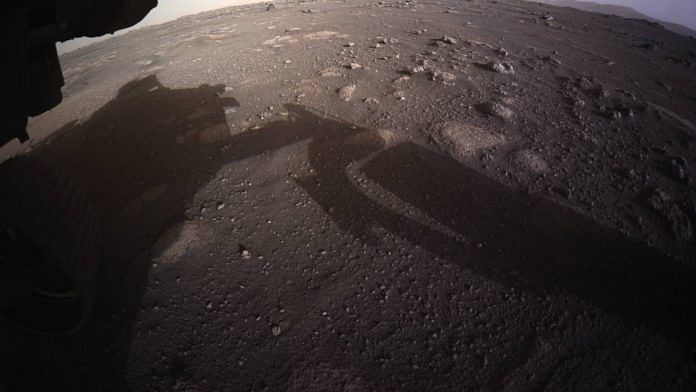New Delhi: Scientists from NASA have found multiple rocks at the bottom of the Jezero Crater on Mars which show evidence of organic compounds, along with significant interaction between rocks and water.
Jezero Crater is where NASA’s Perseverance rover landed in 2020.
The existence of organic compounds — that is chemical compounds with carbon–hydrogen bonds — may be evidence of life. However, future missions returning the samples to Earth would be needed to determine this as these compounds can also be created through non-biological processes.
The minerals and co-located possible organic compounds were discovered using SHERLOC, or the Scanning Habitable Environments with Raman & Luminescence for Organics & Chemicals instrument.
Mounted on the rover’s robotic arm, SHERLOC is equipped with a number of tools, including a Raman spectrometer that uses a specific type of fluorescence to search for organic compounds and also see how they are distributed in a material, providing insight into how they were preserved in that location. Read more.
Also read: Secret behind luminous jets at centre of galaxies solved after 40 yrs, shock waves hold key
James Webb Telescope reveals details of exoplanet atmosphere
NASA’s James Webb Space Telescope has detected the molecular and chemical signatures of an exoplanet, revealing the unique atmosphere of a distant ‘hot Saturn’.
While space telescopes have previously revealed isolated ingredients of this heated planet’s atmosphere, the new readings provide a full menu of atoms, molecules, and even signs of active chemistry and clouds.
The latest data also give a hint of how these clouds might look up close — broken up rather than as a single, uniform blanket over the planet.
The telescope’s array of highly sensitive instruments was trained on the atmosphere of WASP-39 b, a ‘hot Saturn’ orbiting a star some 700 light-years away.
The findings bode well for the capability of Webb’s instruments to conduct the broad range of investigations of exoplanets — planets around other stars — hoped for by the scientific community. Read more.
Ancient turtle the size of a car discovered in Spain
A new species of ancient turtle discovered in Spain may have been one of the largest marine turtles to have ever lived in Europe, according to scientists from the Autonomous University of Barcelona.
With an estimated body length of up to 3.74 meters, it represents the largest marine turtle to have been found in Europe to date.
The largest known marine turtles, such as the ancient extinct genus Archelon, which grew to sizes of 4.6 meters long and weighed up to 3.2 tonnes, lived in the seas surrounding the North American continent towards the end of the Cretaceous period. In contrast, no known European marine turtle — extinct or living — has exceeded 1.5 meters in shell-length.
The team from Spain has found the remains of a new marine turtle specimen — which they have named Leviathanochelys aenigmatica — in the Cal Torrades locality, in northeastern Spain.
The remains, which were excavated between 2016 and 2021, consist of a fragmented, but almost complete pelvis and parts of the upper shell (carapace), and date to the Campanian Age, between 83.6 to 72.1 million years ago.
Based on the size of the pelvis, the authors calculate that Leviathanochelys could have reached a body length of up to 3.74 meters. They estimate that the maximum width of Leviathanochelys’ pelvis was 88.9 centimeters, which is slightly larger than the biggest estimates for Archelon’s best known specimen (81.0 cm wide). Read more.
New study finds our ancient relatives were not so simple
Researchers at the University of Nottingham have solved an important piece of the animal evolution puzzle as their new study reveals that our ancient ancestors were more complex than originally thought.
When animals evolved to have a left and right side, and two gut openings, it brought about a plethora of significant advantages, This helped animals propel themselves forward, increased their speed through water, helped find new sources of food, extract nutrients, and escape predators.
Today, a huge diversity of other animals have bilateral symmetry and two gut openings just like us. They include animals as diverse as starfish, sea cucumbers, elephants, humans, crickets, and snails.
They also include a group of very simple marine worms called Xenacoelomorphs.
For years, scientists have debated who is more closely related to who in this diverse collection of bilaterally symmetrical animals.
Researchers at the University of Nottingham in UK found that Xenacoelomorphs branch much later in time, they are not the earliest branch on the bilaterian family tree, and their closest relatives are far more complex animals like starfish.
This means that Xenacoelomorphs have lost many of the complex features of their closest relatives, challenging the idea that evolution leads to ever more complex and intricate forms.
Instead, the new study shows that loss of features is an important factor in driving evolution. Read more.
(Edited by Poulomi Banerjee)
Also read: Google Doodle celebrates geologist Marie Tharp, known for groundbreaking maps of ocean floor



